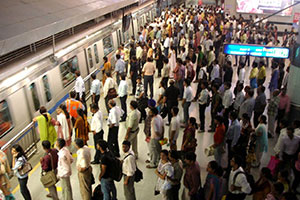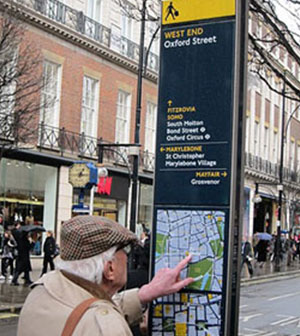Dear Signage, show the right Way!
By Kapil Pandey, VDIS | April 22, 2019
Kapil Pandey, Founder, VDIS, pens down the efficacies and possibilities that signage system can be assigned to.
 Every Indian knows that Delhi is infamous for its lack of civic sense. If you have ever been to a fast-food outlet in the city, you would, most likely, have seen people elbowing or trying to out-shout each other to place or receive their orders instead of waiting for their turn. You may have noticed that such places also tend to have instructional signage that is so ineffectively placed or aesthetically unaligned that you and others tend to disregard them. What’s the connection, you may ask. Both these instances are examples of space designers ignoring an extremely important element that defines user experience – signage!
Every Indian knows that Delhi is infamous for its lack of civic sense. If you have ever been to a fast-food outlet in the city, you would, most likely, have seen people elbowing or trying to out-shout each other to place or receive their orders instead of waiting for their turn. You may have noticed that such places also tend to have instructional signage that is so ineffectively placed or aesthetically unaligned that you and others tend to disregard them. What’s the connection, you may ask. Both these instances are examples of space designers ignoring an extremely important element that defines user experience – signage!
The signage identity of a particular environment has the potential to have a two-fold impact – behavioral and emotional. Research shows that functional and  effective placement of signs can greatly contribute towards behavioral change among end users. A good example of this can be seen at our very own Delhi Metro. Delhi, unlike Bombay, has never had a culture of people queuing up for anything, be it buying tickets or boarding trains and buses. When the Metro started running, most crowded stations, like Rajiv Chowk, Kashmiri Gate and Barakhamba Road became showcases for Delhi’s well-known ‘civic non-sense’! People would nudge, push and elbow each other in an attempt to board or alight from the trains. All it took to change this was the placement of diagonal yellow
effective placement of signs can greatly contribute towards behavioral change among end users. A good example of this can be seen at our very own Delhi Metro. Delhi, unlike Bombay, has never had a culture of people queuing up for anything, be it buying tickets or boarding trains and buses. When the Metro started running, most crowded stations, like Rajiv Chowk, Kashmiri Gate and Barakhamba Road became showcases for Delhi’s well-known ‘civic non-sense’! People would nudge, push and elbow each other in an attempt to board or alight from the trains. All it took to change this was the placement of diagonal yellow  strips on platforms for people waiting to board and the central red strips for people about to alight from the train. This very simple solution has not only made getting off and on a metro train a convenient process, it has also improved the queuing culture of the city per se.
strips on platforms for people waiting to board and the central red strips for people about to alight from the train. This very simple solution has not only made getting off and on a metro train a convenient process, it has also improved the queuing culture of the city per se.
In the context of brands, the signage identity of an ‘environment’ greatly contributes to the overall ‘feel’ that the brand and architecture stand for, and therefore, signage design and materiality should be directly inspired by the brand and architectural identities of the environment. Many architects today make the mistake of designing great spaces and leaving the signage for the real estate owners to figure out. This is the primary reason that most of the signs we see around us are dysfunctional and disparate with respect to the demands of the space. By creating bespoke signage and way-finding identity, institutions and retail spaces can help their audiences to understand what makes their business so special. At VDIS, understanding architectural and brand identities has been the primary aspect of signage design, along with a ‘design thinking’ approach with respect to user needs. While designing the way-finding and interpretation signage scheme for Rajaji National Park, Dehradun, our mindfulness of the feel of the habitat, and the desire to work with local materials as far as possible led us to create signage structures out of stones available within the habitat itself. The architectural patterns at the Nalanda University ruins informed the graphic motifs that were used in the way-finding scheme at the ruins. The jaali patterns in the building architecture overlaid with musical notes were used to reinforce the concept for Heartsong, Experion Developers’ residential condos in sector 108 in Gurgaon. In each one of these cases, the seamless integration of signage into the spaces came in for praise from clients as well as end-users. If used well, signage and way-finding strategies can help pave the way directly to the customers’ hearts.
Corporates, institutions and brands make huge investments in advertising, and much of that investment is aimed at conveying the brand’s attitude and perspective towards life and creating a connect with the audience. In a similar way as advertising and architectural efforts, signage identity showcases the brand’s unique personality, tells its story and helps customers appreciate the brand’s outlook and culture. In a city like London, walking is encouraged with the help of excellent signage and strategically placed maps and pointers, which all serve to help the tourist connect with the heritage and innovations of the city and raise the bar for London as a tourist destination. Signage can directly influence behavior and forge emotional connections. It is therefore critical that as much thought and comparable commercial investment is put into designing and engineering signage identities as into advertising efforts.
Kapil Pandey is founder of Delhi-based signage design and manufacturing firm, VDIS.

_165_265.jpg)
_165_265.jpg)






Comments